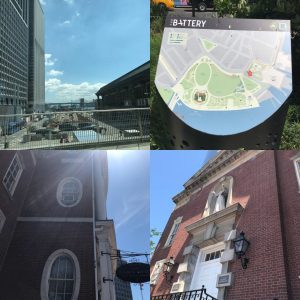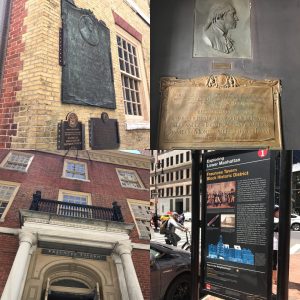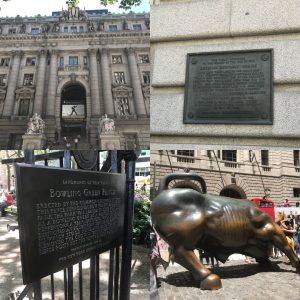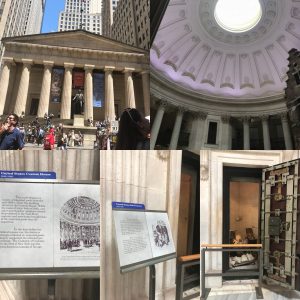On our Urban Tourism class tour to Downtown, Lower Manhattan on Tuesday June 26, 2018, allowed me to rethink of the positive side of things in New York City, about how the city has evolved from ever since I was born. Being informed from Professor Phillip helped me to reflect more about our history, reminding me that we should all value what we have today. Learning about the background of how downtown Manhattan, especially the Battery Park area and the Staten Island Ferry area has transformed from a landfill, help me acknowledge about how New York City have improved economically, visually, and technologically. In addition, learning about the different historical structures, buildings, and monuments such as, the Shrine of Saint Elizabeth Ann Seton, the Frances Tavern, the U.S. Custom House, and the Federal Hall National Memorial, provided me more understanding of why people travel and the importance of history.
During the beginning of the trip, Professor Phillip told us that lower Manhattan, New York City used to be New Amsterdam. She also told us the Battery Park and the Staten Island Ferry used to be a landfill. This lower part of Manhattan is where the city started, where immigrants entered because of Ellis Island. Where the banks begun, commerce trade happened, and where the mayor and the president conducted their businesses. Next stop, the “shrine of Saint Elizabeth Ann Seton who was the first American born saint,” a chapel was built as a home for Saint Elizabeth Ann Seton and her daughter Rebecca. On our walk to another historic site, I saw a mix of modern and older architecture buildings (amazed). If a tourist was interested in food and history, why not stop at the Fraunces Tavern? It is a museum and restaurant (The Dingle Whiskey Bar). According to a plaque on the side of the building it states that this Tavern is where George Washington had his farewell speech after the American Revolutionary War. They also had meetings in this tavern. The building was purchased as a memorial to Fredericks Taumadge. Next stop, our class walked on Stone Street (which had cobblestones from the Dutch) to the Alexander Hamilton U.S. Custom House, which is now the National Museum of the American Indian. This building structure had many different statues or monuments in front of it. This building was listed as the “National Register of Historic Places in 1972 and was designated a National Historic Landmark in 1976.”
Standing right in front of this building is the Bowling Green park. In the park there is a fountain, which once was a statue of George Washington. The fence around the park was very important, there were once crowns part of the fence but were removed. North of the park stood the Charging Bull which is a significant symbol of Wall Street. Next to the Charging Bull is a building called Cunard Line building, where the building had many different uses in the past (a ticketing hall). Now, it is currently open for banquet events, there is also a restaurant and bar service inside. Later, we walked more north to the New York Stock Exchange and the Federal Hall National Memorial. Our class got to enter in the memorial and I thought the interior was gorgeous. This monument was where George Washington was inaugurated and where the first Bill of Rights was adopted. Another site we walked to is the Trinity Church, where there were many gravestones and monuments. I learned that it was the tallest buildings before Brooklyn Bridge towers were built. It is one of the oldest buildings and it was built in 1846. People of importance such as Alexander Hamilton and his wife were buried here. In my culture it is unlucky to tour graveyards, therefore it was a little awkward walking in there.
Last but not least, we got to travel to the 9/11 Memorial and the Oculus. Our class discussed that there is some controversial of having a shopping mall next to where New York City had this tragic attack and is it right for them to make it into a tourist attraction (touristic mall). I mean this place is supposed to be a place of grieve and memorial for the tragic event, but then there is now a touristic attraction to go shopping? This mall is also targeting people of wealth and possibly tourists. The last stop would have been Brookfield place, but me and a few classmates had to leave for another class tour in Long Island City.
I would like to sum it up that this trip will help remind me of the importance of different historical buildings and remind me to be more curious about different things.








